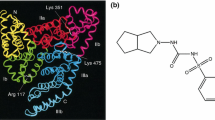Summary
The binding of sisomicin and streptomycin to human serum albumin was studied in the absence of divalent cations by means of the dialysis method. Hydrophobic bonds between albumin and sisomicin or streptomycin can be excluded by nuclear magnetic resonance measurements. The presence of hydrogen bonds is made unlikely according to the result that the binding of the aminoglycosides decreases with increasing number of OH groups in the aminoglycoside molecule. The pH dependence of protein binding suggests that ionic bonds are involved in the binding of aminoglycosides. On the basis of the concentration dependence of the albumin binding of sisomicin and streptomycin we determined the binding affinitiesΔ F°, the binding constants K1, and the maximum number n of aminoglycoside molecules that can be bound by a molecule of albumin in the absence of Ca++ ions. The results were as follows: Sisomicin:Δ F°=−4189 cal/mole, K1=900 1/mole, n=12; Streptomycin:Δ F°=−3512 cal/mole, K1=300 l/mole, n=17.
Zusammenfassung
Die Bindung von Sisomicin und Streptomycin an Humanalbumin wurde in Abwesenheit von divalenten Kationen mittels der Dialysemethode untersucht. Hydrophobe Bindungen zwischen Albumin und Sisomicin bzw. Streptomycin lassen sich durch Kernresonanzmessungen ausschließen. Gegen das Vorliegen von Wasserstoffbrückenbindungen spricht der Befund, daß die Bindung der Aminoglykoside um so geringer ist, je mehr OH-Gruppen ein Aminoglykosidmolekül enthält. Die pH-Abhängigkeit der Eiweißbindung weist darauf hin, daß bei der Bindung der Aminoglykoside ionogene Bindungen vorliegen. Aus der Konzentrationsabhängigkeit der Eiweißbindung von Sisomicin und Streptomycin werden die BindungsaffinitätenΔ F°, die Bindungskonstanten K sowie die maximale Anzahl n von Aminoglykosidmolekülen ermittelt, die ein Albuminmolekül in Abwesenheit von Ca++-Ionen zu binden vermag. Folgendes sind die Ergebnisse: Sisomicin:Δ F°=−4189 cal/mol, K1=900 l/mol, n=12; Streptomycin:Δ F°=−3512 cal/mol, K1=300 l/mol, n=17.
Similar content being viewed by others
Literature
Rosenkranz, H., Scheer, M., Scholtan, W. Die Bindung von Sisomicin und Gentamicin an die Eiweißkörper des Serums. Arzneim. Forsch. 26 (1976) 1517–1521.
Rosenkranz, H., Scheer, M. Bindung von Sisomicin an die Serumproteine des Menschen. II. Einfluß von Ca- und Mg-Ionen. Infection 4, Suppl. 4 (1976) 337–342.
Rosenkranz, H., Scheer, M., Scholtan, W. Binding of aminoglycoside antibiotics to human serum proteins. III. Effect of experimental conditions. Infection 6 (1978) 57–64.
Scholtan, W. Die hydrophobe Bindung der Pharmaka an Humanalbumin und Ribonucleinsäure. Arzneim. Forsch. 18 (1968) 505–517.
Scholtan, W. Über die Bindung der Langzeitsulfonamide an die Serumeiweißkörper. Makromol. Chemie 54 (1962) 24–59.
Nys, P. S., Savitskaya, E. M., Kolygina, T. S. Determination of ionization constants of streptomycin by the indicator method. Pharm. Chem. J. 5 (1971) 576–581.
Tanford, C., Swanson, S. A., Shore, W. S. Hydrogen ion equilibria of bovine serum albumin. J. Am. Chem. Soc. 77 (1955) 6414–6321.
Netter, H. Theoretische Biochemie, p. 146. Springer Verlag, Berlin, 1959.
Weinstein, M. J., Luedemann, G. M., Wagmann, G. H.: Sisomicin and methods for its production. US Patent 3 832 286, 1974.
Ganchev, K., Fishmann, V. M., Libinson, G. S. Potentiometric titration of gentamycin. Pharm. Chem. J. 7 (1974) 441–445.
Thompson, R. Q., Higgins, C. E., Stark, W. M.: Antibiotika. Deutsche Offenlegungsschrift 1 617 451, 1971.
Savitskaya, E. M., Nys, P. S., Fishman, V. M. The use of digital computers for calculating closely similar ionization constants of polybasic compounds. Pharm. Chem. J. 12 (1970) 721–724.
Frohardt, R. P., Haskell, T. H., Ehrlich, J., Knudsen, M. P.: Antibiotic and methods for obtaining same. US Patent 2 916 485, 1959.
Netter, H. Theoretische Biochemie, p. 165. Springer Verlag, Berlin, 1959.
Saroff, H. A., Lewis, M. S. The binding of calcium ions to serum albumin. J. Phys. Chem. 67 (1963) 1211–1216.
Pedersen, K. O. Binding of calcium to serum albumin. II. Effect of pH via competitive hydrogen and calcium ion binding to the imidazole groups of albumin. Scand. J. Clin. Lab. Invest. 29 (1972) 75–83.
Abbott, F., Gomez, J. E., Birnbaum, E. R., Darnall, D. W. The location of the calcium ion binding site in bovineα-trypsin andβ-trypsin using lanthanide ion probes. Biochemistry 14 (1975) 4935–4943.
Rosenthal, H. E. A graphic method for the determination and presentation of binding parameters in a complex system. Anal. Biochem. 20 (1967) 525–532.
Scholtan, W., Schloßmann, K., Rosenkranz, H. Die Bindung von Steroidhormonen und von Steroidguanylhydroazonen an Serumalbumin. Arzneim. Forsch. 18 (1968) 767–780.
Author information
Authors and Affiliations
Rights and permissions
About this article
Cite this article
Scholtan, W., Rosenkranz, H. Ionic binding of aminoglycosides to human serum albumin in the absence of divalent cations. Infection 6, 130–136 (1978). https://doi.org/10.1007/BF01642261
Received:
Issue Date:
DOI: https://doi.org/10.1007/BF01642261



